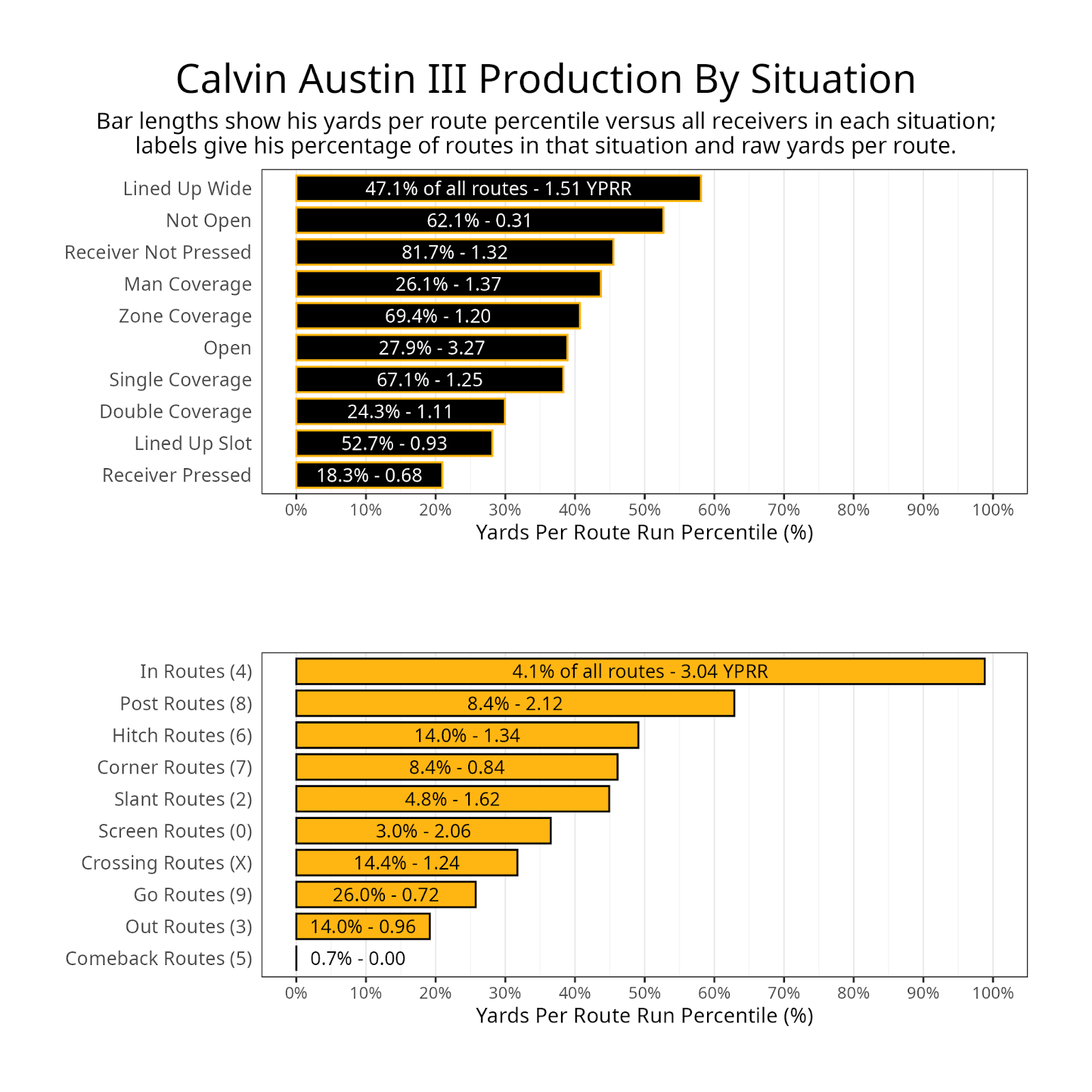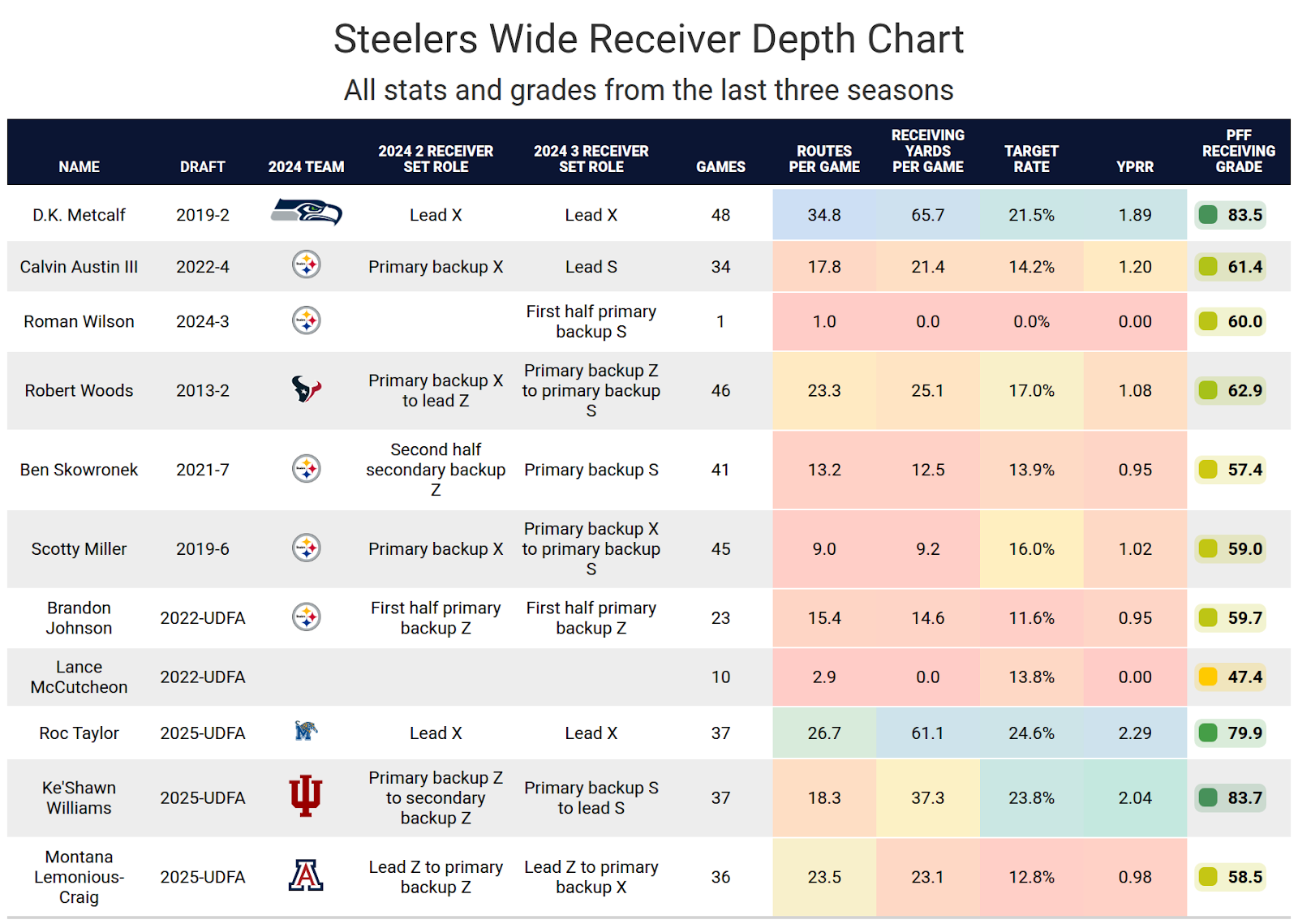
- Late-season improvement: Calvin Austin III finished the 2024 season with increased snap counts and production, establishing himself as a key part of the Pittsburgh Steelers‘ offense heading into the offseason.
- Potential Z Receiver Role: Austin is positioned as the likely Z receiver for the Steelers in 2025, assuming the team does not make further significant trade moves, which offers him a chance for a larger role in the offense.
- Subscribe to PFF+: Get access to player grades, PFF Premium Stats, fantasy football rankings, all of the PFF fantasy draft research tools and more!
Estimated Reading Time: 5 minutes

PFF’s Fantasy Football Player Profile series delivers the most in-depth fantasy football analysis available for the 2025 season.
Using PFF’s exclusive data, we evaluate player performance, competition for touches and how teammates and coaching staffs
Last updated: 7:15 a.m. Tuesday, June 24
Player performance
Calvin Austin III was a fourth-round pick by the Pittsburgh Steelers in 2022. A Lisfranc sprain cost him his entire rookie season. He spent the 2023 season as the fourth wide receiver on the depth chart behind George Pickens, Allen Robinson II and Diontae Johnson.
Early in the season, he was consistently playing at least 50% of Pittsburgh’s offensive snaps. He caught two passes for 72 yards and a touchdown in Week 3. After not catching a pass in Week 5, the Steelers reduced his role after the bye week. He played less than 30% of the snaps each week over the rest of the season. He caught 12 passes in the first four weeks and five passes over the rest of the season.
The Steelers moved on from both Robinson and Johnson but added Van Jefferson and drafted Roman Wilson, who ended up missing nearly all of the season, which allowed Austin to be third on the depth chart. He was generally the third wide receiver in three-receiver sets. He had a strong Week 3 with four receptions for 95 yards and a touchdown but only averaged 28 yards per game over the first 11 weeks of the season.
He started playing better at the end of the season. He scored touchdowns in both Weeks 12 and 13. George Pickens was out in Week 14, so the Steelers initially used a rotation of players, led by Scott Miller, who replaced him. In Weeks 15 and 16, Austin played more on the outside. He caught 65 receiving yards in both games. Pickens returned in Week 17, but Austin continued to play at least 65% of Pittsburgh’s offensive snaps in the last two games, as well as the one playoff game. He was the clear No.2 option at wide receiver, playing ahead of Jefferson.
While Austin didn’t have much consistency, 13.9% of his receptions went for at least 30 yards, sixth-best among wide receivers last season, and 27.8% went for at least 20 yards, eighth-best. He played notably better when lined up out wide, finishing with 1.51 yards per route run out wide in his career compared to 0.93 in the slot.


Projected role
The Steelers traded for D.K. Metcalf and signed free agent Robert Woods while trading away Pickens and letting Jefferson sign with the Tennessee Titans in free agency.
Metcalf will be the clear X receiver in the offense, as he’s been throughout his career. Barring a trade for another receiver, Austin should be the Z receiver in the offense. Wide receiver coach Zach Azzanni stated during OTAs that Austin is in the No. 2 spot. That leaves Wilson, Woods, and potentially even Ben Skowronek and Scotty Miller fighting for the slot job.
This means that Austin should be playing much more on the outside, which puts him in a position to succeed. However, after the Aaron Rodgers addition at quarterback, there will be persistent trade rumors until the Steelers trade for a receiver or the trade deadline passes. Long-time Steelers beat writer Gerry Dulac does not expect them to make a trade. Plenty of writers less connected to the team have linked former Rodgers receivers Allen Lazard or Romeo Doubs to the Steelers. Either one would likely cut into Austin’s potential target share significantly. Dulac says they wouldn’t trade anything more than a fifth-round pick, but it’s also possible it wouldn’t take that much to trade for either receiver. Adding either receiver would make Austin undraftable in redraft leagues.


Impact of teammates
Austin will be in his second season in Arthur Smith’s offense. Smith’s offenses have been incredibly run-heavy, with low usage of three receiver sets and a low target rate to wide receivers. This all works heavily against Austin fantasy-wise. However, in 2020, Corey Davis earned 984 receiving yards and finished 32nd in fantasy points per game as the second receiver in the Tennessee Titans’ offense when Smith was the offensive coordinator.
A lot of Smith’s tendencies might be counteracted by the Rodgers addition. Rodgers has a history of throwing a lot of passes, using mostly three-wide receiver sets and typically targeting his wide receivers. Nearly every wide receiver who has had any level of success with Rodgers has been capable of lining up both outside and in the slot. Metcalf has minimal slot experience, so there is a chance Austin could become a Rodgers favorite.


Bottom line
Austin has a chance to be a regular fantasy starter, as long as the Steelers don’t trade for another wide receiver and the offense can look more like an Aaron Rodgers offense and less like an Arthur Smith offense.

Footnotes
- Statistics in tables and charts were chosen based on their ability to predict future fantasy performance on a per-game or per-opportunity basis or to describe the player relative to others at the same position.
- “Opportunities” are defined as passing dropbacks, rushing attempts and routes run as a receiver.
- Numbers are provided either by season or based on the past three years. For rookies, only college statistics are included. For non-rookies, only NFL statistics are considered, regardless of whether they played in college within the previous three years.
- As college competition is easier than NFL competition, most rookies are likely to see a decline from their historical numbers.
- Only FBS data is considered for college players and comparisons.
- Kneel-downs are removed from rushing data to provide cleaner quarterback rushing rate statistics.
- The table colors in this article range from blue (indicating good/high) to red (indicating bad/low).
- All percentiles and color codings compare the given player to others with a high sample of opportunities. Generally, the cutoff is one-third of the possible opportunities in the sample. If a player does not meet the threshold, they are still included in the comparison, though their results may appear better or worse than expected due to the smaller, less predictive sample size.
- Information on utilization classifications and their importance can be found here for running backs, wide receivers and tight ends.
This news was originally published on this post .







Be the first to leave a comment